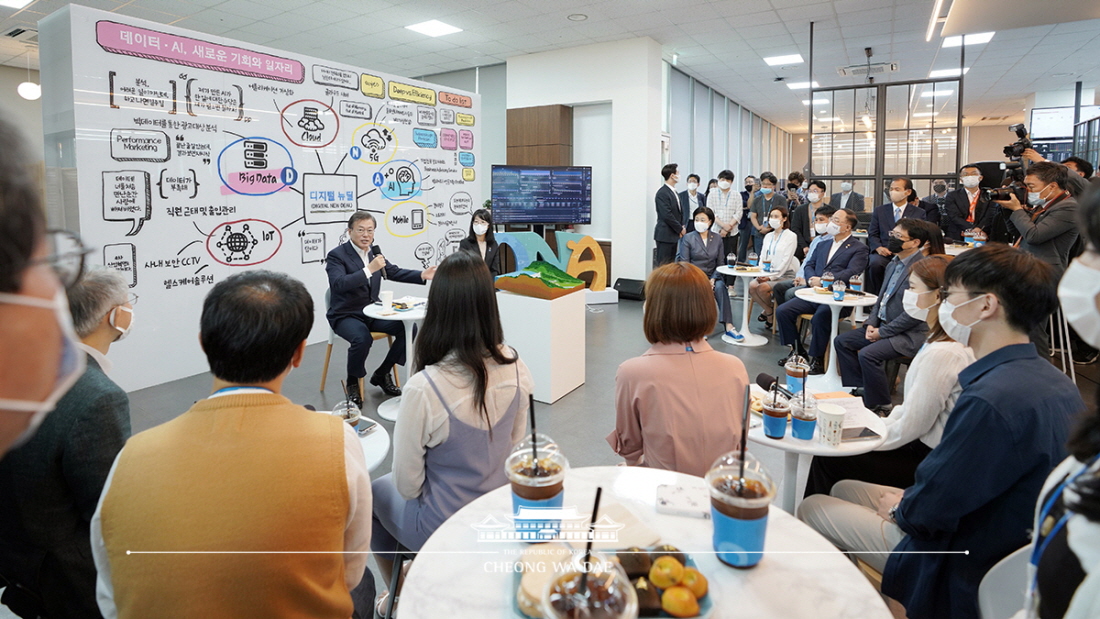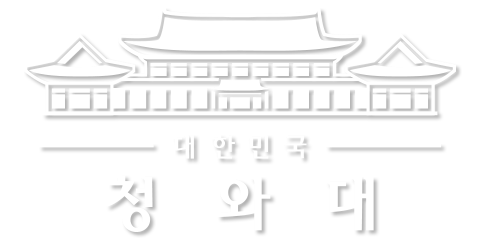이 웹사이트는 제19대 대통령 임기 종료에 따라 대통령기록관이 「대통령기록물 관리에 관한 법률」에 의해 이관받아 서비스하는 대통령기록물입니다. 자료의 열람만 가능하며 수정 · 추가 · 삭제는 불가능합니다.
다만, 「개인정보보호법」에 의하여 개인의 정보를 보호받기 원하시는 분은 관련 내용(요청자, 요청내용, 연락처, 글위치)을 대통령 웹기록물 담당자(044-211-2253)에게 요청해 주시면 신속히 검토하여 조치해 드리겠습니다. 감사합니다.
SPEECHES & REMARKS
BRIEFINGS
Remarks by President Moon Jae-in During Visit to Business in Digital Economy, Korean Version of New Deal

Good morning, I am glad to meet you all. Thank you for your great presentation. Douzone Bizon may not be a conglomerate yet it is a mid-market company. I was told it’s the Republic Korea’s foremost business specializing in data and artificial intelligence. I am very proud of you.
The Government is now pushing for a Korean version of the New Deal to overcome the COVID-19 crisis and respond to the post-COVID-19-era. The most important pillar is a Digital New Deal. Douzone Bizon is the leading company in this Digital New Deal. All of you can be referred to as leading actors blazing the Digital New Deal trail. I’m placing high hopes on you.
Let me explain why we call it the Korean version of the New Deal. As you know, the original New Deal was the policy adopted by U.S. President Roosevelt to surmount the crisis of the Great Depression. One of the pivotal pillars of that policy was to promote the rights and interests of workers by introducing a welfare system on one hand and to create many jobs through massive civil engineering projects on the other. The perfect example is the Hoover Dam. I don’t know where it ranks today in terms of size, but it was the world’s largest dam at that time. The first step was to construct a massive dam and store up a huge reservoir of water. Then, the spillways were opened and the trapped water allowed to flow. Some of it is used for power generation, some for agricultural irrigation or industrial purpose and the rest is used as drinking water. The dam also provides the means to control floods and droughts. For these reasons, we call it a multi-purpose dam.
The initial phase called for an immense amount of funds to carry out yearslong construction that generated a great number of jobs. After completion, many related industries arose using the water in various ways. The prosperity of such industries gave rise to the creation of jobs.
Furthermore, a huge, very beautiful artificial lake has formed to hold water in the upper reaches of the dam. The spectacular scene of falling water has naturally attracted attention; the dam has emerged as a very popular tourist destination. This has led to the building of accommodations and even entertainment establishments such as casinos in the surrounding area. On top of this, a new town has arisen thanks to the jobs generated during the dam’s construction. As tourism has grown, the town has expanded. The aim was to create jobs and revive the economy through a virtuous cycle.
Our purpose is the same. But now, we can no longer achieve the goal through that sort of massive civil engineering project. The Digital New Deal we are pursuing will create a so-called “data dam” to maximize the data utilization that will become the foundation of the digital economy going forward. This data dam will amass data generated through our public and private networks. Currently, raw data collected in this way cannot be utilized as it is; we need to standardize and combine the data in order to process it. In addition, we have to generate de-identified data – with personal information sorted out as a safeguard. The more this data is utilized through such a process, the smarter artificial intelligence will become. Through networks, artificial intelligence can bring about innovation through the smartization of existing industrial complexes and, subsequently, factories. Furthermore, it can also help create various innovative industries that were not possible in the past as well as non-face-to-face and other innovative services. In this way, we’ll be able to revive our economy and create a foundation for the digital economy going forward so that Korea can move toward a pace-setting economy in the post-COVID-19 era.
Moreover, the steps of collecting, standardizing, processing and combining data all have to be done by people. Consequently, these steps can create many jobs as well. The Digital New Deal, among the policies with the Korean version of the New Deal pursued by our Government, is similar to the policy taken by the United States when it was building the Hoover Dam. Clearly, we can see that it has now taken on a different shape in line with the current era.
If the Digital New Deal is successful, I believe that we will be able to succeed by getting ahead of other countries in the post-COVID-19 digital economy. I believe that those of you here will play leading roles. You are mid-market companies at present, but I expect that when the time comes, you will likely be standing tall as large world-class enterprises.
I believe there are several important points. Foremost, it’s now necessary for data generated in both the public and private sectors to be boldly opened up so that businesses can utilize it. As I said earlier, during the process of opening up data, it needs to be thoroughly turned into de-identified forms so that private information is not infringed upon. The digital economy will create numerous new jobs while making our industries upgraded and innovated, but it can also eliminate existing jobs in industries. Thus, we have to simultaneously implement national projects to transfer people who used to work for old industries into newly created jobs.
Moreover, in the digital economy, the digital divide between those who have easy access to digital resources and those who do not can further aggravate the current gap in our society. I believe that another daunting task facing us is to create a so-called inclusive digital economy by narrowing this gap.
I’ve been speaking in a slightly theoretical manner so far. If you actually encounter difficulties of any kind while doing business or have any requests for the Government, please feel free to discuss them.
Thank you.



